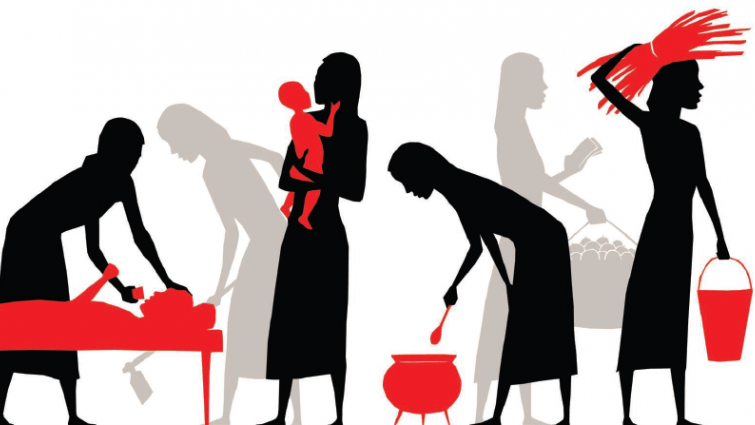The gender inequality of the patriarchal Indian society is not only a social issue but an economic reality as well. India has one of the largest gender pay gaps in the world, with women earning approximately 25% less than men as of 2016. Women are systematically marginalised unless they prove their worth in male-dominated fields of work. In addition to this, women also carry the burden of additional work, which receives neither respect nor remuneration. A UN report shows that over 51% of the work done by women is unpaid, and is not counted in the nation’s GDP and other statistics.
Unpaid labour does not only affect women, but it affects them the most. A large part of their work, from working for the household farm or business to domestic and caregiving work is delegitimised as women’s work and is not considered ‘real’ work. For instance, maintaining the house and raising children is still considered the woman’s prerogative, while men ‘help out’ when they can. So a significant part of women’s work remains socially unrecognised till this date.
Studies show that women makeup almost 60% of the agricultural labour force in Africa and Asia, and own less than 20% of agricultural land. Yet women are not recognised as farmers, reducing their work to unpaid family farm labour or underpaid labour. Similarly, women perform 75% of the world’s unpaid care work, almost 10 to 12 times the work done by men. Yet none of this labour is accounted for in the country’s GDP. But the largest source of women’s unpaid labour is domestic work.
Unpaid Domestic Labour
Unpaid domestic labour refers to all work required to maintain the household– from chores such as grocery shopping, cooking and cleaning, to taking care of the children, sick and elderly within the family. In rural areas, this also includes daily tasks such as collecting firewood and water. The labour involved in running a household and managing daily tasks is not just physical, but also mental and emotional. And since it is not considered real work, it is devalued by the men who benefit from it, and the women who themselves engage in it.
Even when women try to enter the workforce, unpaid domestic labour becomes a major obstacle in their access to paid work opportunities. Although women’s inclusion into the workforce is considered to be a sign of empowerment, it leaves them with a double burden. They have to handle work responsibilities in addition to their unpaid domestic work. When one woman steps out of the house to work, the responsibility of domestic work falls on the other women in the house. In nuclear families where both the partners work outside, women are still responsible for almost all house and family-related work. Research shows that women spend more than twice the time on domestic work than men, which means that women work for more time on a daily basis than men.
the largest source of women’s unpaid labour is domestic work.
In some cases, when women begin working outside the house, the housework falls upon domestic workers, a majority of which are underpaid women from marginalised backgrounds. It is assumed that women from well to do families are more likely to join the workforce, as they can afford to pay other women to take care of the domestic work, and poorer women forego paid work to fulfil their ‘domestic responsibilities’. But in India women from affluent families are often restricted from joining the workforce in the name of culture and tradition, while poorer women are forced to shoulder the double burden in order to sustain their livelihoods.
Domestic Work and Quality of Life

Sometimes unpaid domestic work is brushed off as personal care and leisure. For example, cooking, cleaning, childcare and gardening are all examples of unpaid work, because another person can be paid to do them. But a third person cannot be paid to watch a movie or learn a new skill, which falls under leisure.
But women often do not get enough time for personal care and leisure. In fact, domestic labour often has negative effects on the health and well-being of women and lowers their overall quality of life. While formal jobs have fixed timings and holidays, women have to constantly engage in unpaid domestic labour. (Remember the phrase “Being a mother is a full-time job”?) Anything from marriage to ill-health in the family can put additional pressure on women, forcing them to exit the workforce or find underpaid or part-time jobs.
If this wasn’t bad enough, unpaid labour has been increasing in the last decade, because of reductions in public spending and health services, or because of well-meaning but gender-blind policies. For instance, an afforestation movement might safeguard certain forest land, but will force women to walk further in search of firewood, increasing their time spent on unpaid labour. In fact, recent labour surveys in India show that more than 80% of women engage in unpaid domestic work, almost seven times the work done by men. It is not surprising then, that women’s workforce participation has fallen from 31% in 2004 to 24% in 2011, despite economic and educational growth.
Also Read: Women’s Workforce Participation: What Does The Data Say?
Benefits of Recognising Unpaid Labour
There is a clear economic benefit in recognising domestic and other unpaid work as legitimate work. The value of unpaid domestic and care work done by women is estimated to be 13% of the global GDP. But in India, the value is a whopping 39% of its current GDP. This means that a major chunk of India’s productive potential is not even included in its monetary calculation. But the benefit of recognising unpaid labour goes beyond just economic gain. Domestic labour keeps the family unit running and makes work outside the house possible, for people of all genders.
Though the government has started recognizing women’s unpaid work. The National Rural Employment Guarantee Act (NREGA), 2005 is the first step towards empowering rural women and tackling the problem of unpaid and underpaid agricultural work. However, we are still far away from recognising domestic work as legitimate labour.
For real equality, unpaid domestic work needs to be legitimised and given due recognition.
We need to remember that empowerment cannot be found by simply rejecting the unpaid domestic work women have been shouldering for decades in favour of working outside the homes. Because when women step out of the house to work, the question of ‘who will do the housework’ still remains. And because domestic work is still gendered, the responsibility eventually falls on women themselves. This promotes ideas like women aren’t competent workers, or that they have other priorities beyond their work.
Equal opportunity for work cannot be just about increasing pay for women, or increasing their participation in the workforce, but about redefining the current patriarchal definition of work. This will un-gender domestic and care work, minimising women’s work and improving their quality of life.
For real equality, unpaid domestic work needs to be legitimised and given due recognition. Only then can we expect equal participation in the workforce, and in the household.
References:
Measurement of Unpaid Household Work of Women in India
Women’s work in India in the early 21st century
Making unpaid work visible creates livelihoods for rural women
Over 51pc of work done by women in India is unpaid: UN Report
Featured Image Credits: Book of Life 01



